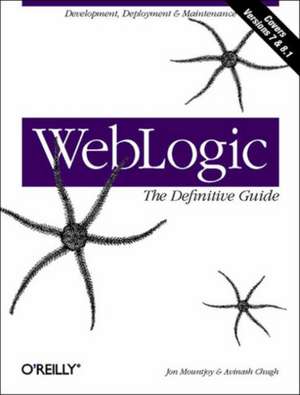WebLogic: The Definitive Guide: Definitive Guide
Autor Jon Mountjoy, Avinash Chughen Limba Engleză Paperback – 4 mar 2004
BEA's WebLogic Server implements the full range of J2EE technologies, and includes many additional features such as advanced management, clustering, and web services. Widely adopted, it forms the core of the WebLogic platform, providing a stable framework for building scalable, highly available, and secure applications. In fact, in the long list of WebLogic's strengths and features, only one shortcoming stands out: the documentation that comes with the WebLogic server often leaves users clamoring for more information.
WebLogic: The Definitive Guide presents a 360-degree view of the world of WebLogic. Providing in-depth coverage of the WebLogic server, the book takes the concept of "definitive" to a whole new level. Exhaustive treatment of the WebLogic server and management console answers any question that developers or administrators might think to ask. Developers will find a useful guide through the world of WebLogic to help them apply their J2EE expertise to build and manage applications. Administrators will discover all they need to manage a WebLogic-based setup. And system architects will appreciate the detailed analysis of the different system architectures supported by WebLogic, the overall organization of a WebLogic domain and supporting network infrastructure, and more.
WebLogic: The Definitive Guide is divided into three sections that explore WebLogic and J2EE, Managing the WebLogic Environment, and WebLogic Enterprise APIs. Some of the topics covered in this comprehensive volume include:
- Building web applications on the WebLogic Server
- Building and optimizing RMI applications
- Using EJBs with WebLogic, including CMP entity beans
- Packaging and deploying applications
- Understanding WebLogic's support for clustering
- Performance tuning and related configuration settings
- Configuring WebLogic's SSL support
- Maximizing WebLogic's security features
- Building web services with XML
- Using WebLogic's JMX services and MBeans
Preț: 343.73 lei
Preț vechi: 429.66 lei
-20% Nou
65.80€ • 68.66$ • 55.16£
Carte tipărită la comandă
Livrare economică 13-27 martie
Specificații
ISBN-10: 059600432X
Pagini: 848
Dimensiuni: 178 x 235 x 44 mm
Greutate: 1.21 kg
Editura: O'Reilly
Seria Definitive Guide
Cuprins
Notă biografică
Jon Mountjoy has worked with J2EE technologies since their inception, and with WebLogic in particular. He currently works as a Product Development Manager at a firm specializing in risk management, and has held posts training and consulting in J2EE technologies. Jon has a post-graduate degree in computer science.
Avinash Chugh presently works as Senior Development Manager for a firm that produces software for the regulated industries (finance, energy, pharmaceutics). He has over three years experience with J2EE technologies, primarily on the WebLogic Server. Avinash holds a post-graduate degree in computer applications from Delhi University. He likes to spend his free time on vegetarian cooking, racquet sports, and ambient/experimental music.























